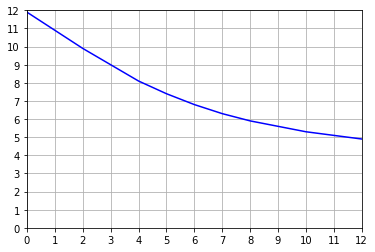Compute the bayesian upper limit for a Poisson near the physical boundary#
import numpy as np
from scipy.stats import poisson
import matplotlib.pyplot as plt
from math import exp
%matplotlib inline
confidenceinterval = 0.95
beta = 1 - confidenceinterval
# parameters
nobs = 6
vb = 3
max_obs = 20 # range to compute the Poisson distribution
k = np.arange(0, max_obs, 1)
def numerator(nobs, vs_up, vb):
N = poisson.pmf(k, vs_up + vb)
sum = 0
for i in range(nobs+1): # range stops at nobs -1
sum+=N[i]
return sum
def denominator(vb):
N = poisson.pmf(k, vb)
sum = 0
for i in range(nobs+1): # range stops at nobs -1
sum+=N[i]
return sum
# Compute upper boundary
vs_up = 0
s = 0
scan_step = 0.01
ck = True
while (vs_up < 2000) and (ck):
vs_up = s * scan_step
# print ("\nSignal = ", Signal)
ratio = numerator(nobs, vs_up, vb)/denominator(vb)
if (ratio < beta):
ck = False
# print (Signal, sum)
s+=1
print ("95% CL Upper limit on Nobs = ", nobs, " with an expected background vb = ",vb, "\nvs_up = ", vs_up)
95% CL Upper limit on Nobs = 6 with an expected background vb = 3
vs_up = 8.91
import numpy as np
from scipy.stats import poisson
import matplotlib.pyplot as plt
from math import exp
%matplotlib inline
confidenceinterval = 0.95
beta = 1 - confidenceinterval
# parameters
nobs = 6
vb_min = 0
vb_max = 12
max_obs = 20 # range to compute the Poisson distribution
k = np.arange(0, max_obs, 1)
def numerator(nobs, vs_up, vb):
N = poisson.pmf(k, vs_up + vb)
sum = 0
for i in range(nobs+1): # range stops at nobs -1
sum+=N[i]
return sum
def denominator(vb):
N = poisson.pmf(k, vb)
sum = 0
for i in range(nobs+1): # range stops at nobs -1
sum+=N[i]
return sum
# Compute upper boundaries
v_vs_up = []
v_vb = []
print ("95% CL Upper limit on Nobs = ", nobs)
nsteps = 12
scan_step = 0.1
for i in range(nsteps+1):
vb = vb_min + i/nsteps*(vb_max-vb_min)
vs_up = 0
s=0
ck = True
while (vs_up < 2000) and (ck):
vs_up = s * scan_step
ratio = numerator(nobs, vs_up, vb)/denominator(vb)
if (ratio < beta):
ck = False
s+=1
print ("vb = {:.2f}".format(vb), " vs_up = {:.2f}".format(vs_up))
v_vs_up.append(vs_up)
v_vb.append(vb)
plt.plot(v_vb, v_vs_up, 'b-')
plt.axis([0,12,0,12])
plt.xticks(np.arange(0, 13, 1.0))
plt.yticks(np.arange(0, 13, 1.0))
plt.grid()
plt.show()
95% CL Upper limit on Nobs = 6
vb = 0.00 vs_up = 11.90
vb = 1.00 vs_up = 10.90
vb = 2.00 vs_up = 9.90
vb = 3.00 vs_up = 9.00
vb = 4.00 vs_up = 8.10
vb = 5.00 vs_up = 7.40
vb = 6.00 vs_up = 6.80
vb = 7.00 vs_up = 6.30
vb = 8.00 vs_up = 5.90
vb = 9.00 vs_up = 5.60
vb = 10.00 vs_up = 5.30
vb = 11.00 vs_up = 5.10
vb = 12.00 vs_up = 4.90


